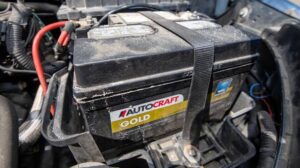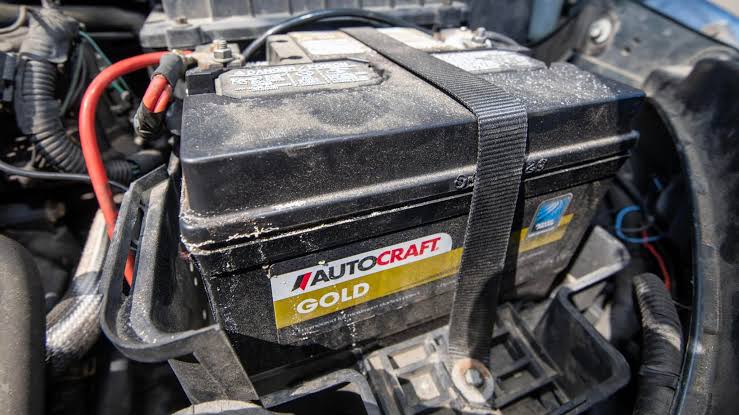VOICE AIR MEDIA News Update
At the era of fuel subsidy, highlights of car maintenance is needful.

Disconnecting your car battery is a relatively simple process.
It involves these 5 steps:
Turn Off Ignition And Locate The Battery
Disconnect The Negative Terminal First
Disconnect The Positive Terminal Second
Detach Holding Mechanism And Remove Battery
Clean The Battery Tray And Cable Connector
However, before you get started, you’ll need some battery removal tools and safety measures in place:
Tools Needed
Battery terminal bolts aren’t a standard size — they can be a single bolt, a clamp, or a bolt and nut pair. So it’s best to have a socket wrench kit, an adjustable wrench (pliers) ready to cater to different sizes and forms.
You may also want some anti-corrosion grease or rust spray on hand.
Safety Measures
Before beginning work on the car’s battery, here are some precautions to keep you and your vehicle safe:
Work in open space:
Batteries contain chemicals that produce flammable gas. Work in an open environment to minimize the possibility of gas buildup and exposure.
Dry workspace:
Never work in wet areas. The car battery holds an electric charge, and you don’t want to risk an electric shock channeled through wet surfaces.
Remove metal jewelry:
Metal is conductive, so remove any jewelry to minimize the risk of an electric shock from accidental contact with a battery terminal.
Wear safety equipment:
Use safety gloves and safety goggles if available.
Driver door open:
Leave the driver door open, as some cars can lock themselves when the battery is disconnected.
Shift into Park or 1st:
If you drive an automatic car, make sure it’s in “Park,” and if it’s a manual car, make sure it’s in first gear to prevent it from rolling.
Also, note that some electronics (like the clock, radio, or the engine control module) may lose their settings without battery power. To prevent this, you may want to use a car memory saver to retain those settings.
It’s also a good idea to check your car manual to see what electronics will be affected by the loss of battery power.
Once you’ve taken care of all of that, you can start disconnecting your battery by following these steps:
Step 1. Turn Off Ignition And Locate The Battery
Turn off the car’s ignition switch and remove the key.
You’ll then need to locate your car battery.
Most of the time, it’ll be in the engine bay.
However, some batteries are located in the trunk or under a rear seat — making them a little harder to access. Refer to the car manual if you can’t find it.
Once you’ve located the battery, check it for corrosion, damage, or leakage.
If a car battery terminal is heavily corroded, disconnecting the cable clamp or connector from the battery post may be more challenging. Don’t try to force the connector off, as you could break the battery post.
In this case, you’ll need to loosen some of the corrosion first. A solution of water and baking soda, and the aid of a wire brush, can help to clear corrosion.
If you want a detailed walkthrough on how to remove corrosion, check out our related post on battery corrosion guide.
If the car battery is damaged, bloated, or leaking, don’t work on it.
Call a mechanic to deal with it instead, as you’ll likely have to replace it.
Step 2. Disconnect The Negative Battery Terminal First
Some battery terminals are covered with plastic caps that you’ll have to remove.
The negative battery terminal is usually marked with a minus (-) symbol and has a black cap. The positive terminal typically has a plus (+) symbol and a red cap.
When disconnecting a car battery, always remove the negative connector (negative clamp) from the negative terminal first. This helps to avoid an electric issue like sparks and shocks and, in some cases, battery explosion.
How do you disconnect it?
Gauge the size of the socket wrench you’ll need (it’s usually around 10mm), fit it over the connector bolt, and turn left (counterclockwise) to loosen.
Important: Don’t let your adjustable wrench touch both terminals simultaneously, as you’ll create an electrical path.
Once the negative connector and negative cable have been released, remove them and keep them aside, away from the battery and positive terminal.
Step 3. Disconnect The Positive Terminal Second
After the negative car battery terminal is disconnected, do the same for the positive terminal.
Loosen the positive connector and positive cable with the pliers, then keep them away from the battery and negative cable.
Don’t let the positive connector touch any metal part of your car, as it can carry a residual current that may damage or disrupt vehicle circuitry.
Step 4. Detach Holding Mechanism And Remove Battery
Most batteries are secured to the battery tray with a holding mechanism. This is usually a bracket or strap.
Find the holding bolts and loosen them so you can detach the holding mechanism. Some bolts are close to the base of the tray, and you may need to reach further down with the socket wrench.
Batteries can be surprisingly heavy, often weighing between 40-60 lbs.
Keep this in mind when you lift the battery off the battery tray.
If you’re removing a flooded lead-acid battery, lift it straight up to avoid sloshing the battery acid inside.
Then, place the old battery on a level surface.
Step 5. Clean The Battery Tray And Battery Cable Connector
Once battery removal is complete, you’ll want to clean the battery tray and cable clamp or connector for future use. Do this irrespective of if you’re installing a new car battery or just taking the car battery out for a recharge.
Clean the battery tray and connectors of any dirt and corrosion, then spray it with an anti-corrosion compound.
Always make sure each battery cable is secured out of the way.
Don’t leave them hanging loose from your engine bay.
What’s next?
If you plan to install a new battery or put back the current one, reverse the entire process:
Secure the battery with the holding mechanism before reconnecting the terminals
Apply some anti-corrosion grease on each battery terminal and connector
When reconnecting the car battery, connect the positive terminal first, then negative
Note: Disconnecting and reconnecting a car battery isn’t difficult and is something you can do yourself with a little bit of care and attention.
However, always get a professional to handle the task whenever you’re in doubt.
Now that you know how to disconnect and remove your car battery, let’s go over some FAQs.
6 Car Battery FAQs
Here are some answers to common car battery questions:
1. Why Would I Need To Disconnect The Car Battery?
There are many reasons for disconnecting the car battery from the engine bay.
Here are some of the usual ones:
A. Replacing A Faulty Battery
Putting in a new battery is one of the most common reasons for disconnecting the battery.
Make sure the old battery is disposed of properly.
B. Recharging A Flat Battery
You may want to use a battery charger to recharge a flat car battery.
Sometimes you don’t have to remove the battery from the engine bay, only disconnect the cables and hook the battery to the car battery charger.
If you’re uncertain about using a battery charger, get a mechanic to handle the task for you. You’ll also have the benefit of asking them to test it for you to find out why there’s a battery drain in the first place.
C. Cleaning Battery Corrosion
Corroded battery terminals should be cleaned, as corrosion affects battery performance and can shorten its life.
It’s often a good idea to take out the battery from the engine compartment when cleaning to prevent corrosive elements and cleaning agents from falling on engine parts.
D. Performing Car Maintenance
Some car maintenance procedures may require the battery to be disconnected or taken out of the way to access engine parts.
E. Storing A Car For An Extended Period
If you plan on storing a vehicle for an extended period, it’s advisable to disconnect at least the negative terminal from your car battery. This prevents unnecessary battery drain, as a fully charged battery can hold its charge for 6-12 months if you do this.
Alternatively, you can use a battery disconnect switch (also known as a kill switch) which attaches to the negative terminal to cut the electrical connection. The battery disconnect switch makes an excellent anti-theft device for other times too.
And finally, if you plan to leave your battery unused for a long time, you may want to attach it to a battery tender to help maintain its charge. The battery tender ensures that it can be up and running when you need it again.
2. What’s A Lead Acid Battery?
The lead acid battery is the most common car battery type. It can be in a wet cell (flooded) or a dry cell (gel or AGM) format. The battery generally consists of lead plates and battery acid (a mixture of water and sulfuric acid).
However, lead acid batteries aren’t the only type of battery out there.
Check out the different car battery types available.
3. What Does The Car Battery Do?
The primary battery function in the car is to provide a spark to the starter to crank the engine.
The car battery also provides power for every electrical component in your car — from the headlights to the onboard computer.
When your car is running, the alternator recharges the battery.
But your battery runs on its own stored charge when the engine is off. This is why it’s essential to avoid unnecessary drain from any electrical system (like the headlights) when you’re not running the car.
4. Can I Recharge A Dead Battery?
Successfully recharging a dead battery depends on how depleted the battery is.
This is a good time to have a voltmeter or multimeter handy, so you can measure your battery voltage and have an idea of its state of charge.
If the battery voltage is 12-12.4V, it still has about 25-75% of its charge, but not enough to start the car.
In this case, you can pull out the jumper cable, jump start the car and take it for a drive to let the alternator recharge the battery. Minimize the use of any electronics and keep the car above idle as much as possible. Aim for about 30 minutes of driving.
If the battery voltage is under 12V, the battery is fully discharged. You can still use a jumper cable to start the car but charging with the alternator is not advisable when the car battery is this depleted.
It’s better to use a dedicated car battery charger to recharge a depleted car battery. Just be aware that a very old battery could be unrecoverable.
Learn more about why your car battery might not be charging.
5. What Mistakes Can I Avoid When Replacing My Car Battery?
Here are three crucial mistakes every car owner should avoid when replacing a car battery:
A. Waiting Too Long
Many car owners make the mistake of waiting too long before replacing a failing battery.
This could eventually lead to your car breaking down or a severe accident. It’s a good idea to be preemptive and replace your car battery as soon as possible.
B. Using The Incorrect Battery
You don’t want to waste money on a battery that isn’t going to work in your car.
You can find the correct battery by reading some car reviews and learning about basic battery specifications for your particular vehicle, like:
Battery size:
Determines if the battery will fit into your car
Terminal placement:
Ensures the battery will connect with your car’s electrical system.
C. Going For The Cheapest Option
Most car insurance plans don’t cover battery replacement costs, but this doesn’t mean you should go for the cheapest replacement option.
While it can be tempting to look for a cheaper battery, it might not provide enough power for every electrical component in your car or even last as long as you’d like.
Instead, as a car owner, you should consider investing in one that offers improved specifications, features, and lifespan.
Learn more about how long a car battery lasts.
6. What’s An Easy Way To Replace The Car Battery?
If your car battery fails, the battery warning light or check engine light will probably illuminate on the dashboard.
But there’s no need to panic.
RepairSmith can help you sort out your battery issues and fit in a new battery if required.
What’s RepairSmith?
RepairSmith is a convenient mobile vehicle maintenance and repair solution.
Here are some excellent reasons to keep us in mind:
Expert technicians execute your vehicle inspection and servicing
Online booking is convenient and easy
Competitive, upfront pricing
All maintenance and fixes are conducted with high-quality tools and replacement parts
RepairSmith offers a 12-month | 12,000-mile warranty for all repairs
Car battery replacement costs will vary based on the car’s make, model, and location. For an accurate estimate of the cost, fill out this online form.
Final Thoughts
Disconnecting a car battery isn’t hard to do. The most important thing to remember is that the negative terminal comes off first.
And when you’re reconnecting the battery, just reverse the sequence.
However, if you have other battery issues and want to be extra safe, just contact RepairSmith and let our expert technicians perform the car battery replacement and other repairs right in your driveway!









